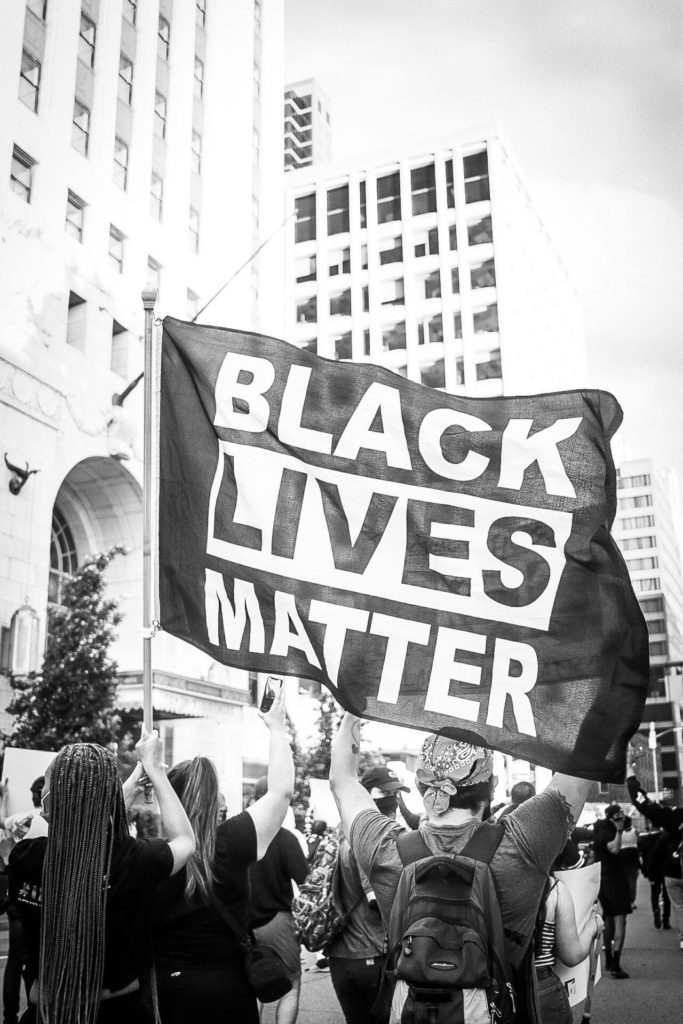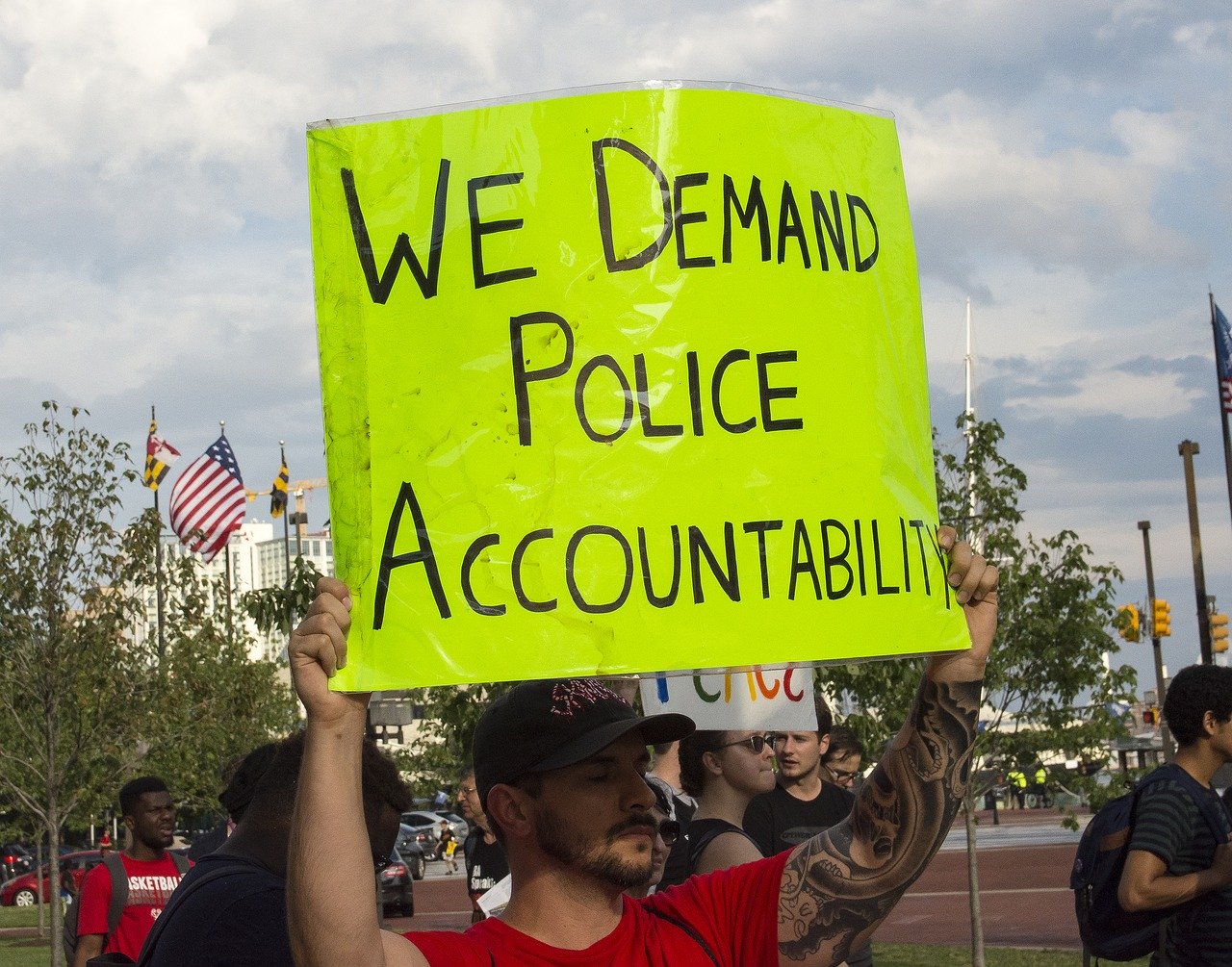“I believe our voices should be heard,” she said.
Protests have erupted across the U.S. for the past week over the death of George Floyd, an unarmed black man, at the hands of a police officer in Minneapolis, Minnesota. National Guard members have been activated in at least 23 states and Washington, DC. And about 4,000 people have been arrested nationwide. While most protesters are peaceful, carrying “black lives matter” signs, some have turned aggressive, looted, and set ablaze buildings and cars.The police have been aggressive too, striking protesters with batons, hitting them with rubber bullets and pepper spray. In New York City, a police truck ploughed through a crowd of protestors.
Selah protested not only because of George Floyd but because of what she calls “discrimination and an over militarized and combative police system in general.”
Her boyfriend, Tyler, protested with her. “Police here can be brutal whether someone is armed or not,” he said.
 What happened to George Floyd?
What happened to George Floyd?
On May 25, George Floyd, 46 was arrested by a white police officer after a deli employee called 911, accusing him of buying cigarettes with a counterfeit $20 bill. Police officer Chauvin, kneeled on Floyd’s neck while he was pinned to the floor for more than 8 minutes, resulting in his death. Among his last words were “I can’t breathe”.
West Virginia Governor Jim Justice said during a news briefing on Monday, “I don’t see how in the world a thing like that could happen, especially when an individual is crying out, you know, and saying they can’t breathe.”
Officer Chauvin worked for the Minneapolis Police Department for more than 18 years. Now, he faces charges of third-degree murder and second-degree manslaughter. If convicted, he faces up to 25 years in prison.
An end to police brutality
But the charges won’t end the fury across the U.S. as protests are calling for an end to systemic discrimination and police brutality that disproportionately affect black Americans, of which George Floyd was just one victim. Names including Breonna Taylor, who was shot dead by police in Louisville in March, and Eric Garner, who died on Staten Island in 2014, were on signs carried by those in the crowd, and in their chants.
Black Lives Matter, a global organisation that campaigns against violence and systemic racism towards black people said George Floyd’s violent death was a breaking point — an all-too-familiar reminder that, for black people, law enforcement doesn’t protect or save our lives. They often threaten and take them.”
Tyler said he was anxious to see how police would react. “The police were only reactionary the first night. Pepper spraying and shooting rubber bullets after things were thrown at them. The second and third night the police came to control. Massive swat trucks, black vans full of soldiers driving around shooting protests with rubber bullets. Some protesters were violent, but most were not,” he said.
 Between 2013 and 2019, police in the US killed 7,666 people, according to data compiled by Mapping Police Violence, a research and advocacy group. Despite there being six times more white people than black people in the US, black Americans are 2.5 times more likely to be killed by the police.
Between 2013 and 2019, police in the US killed 7,666 people, according to data compiled by Mapping Police Violence, a research and advocacy group. Despite there being six times more white people than black people in the US, black Americans are 2.5 times more likely to be killed by the police.
Countless studies show the deep inequities throughout America’s criminal justice system, from being stopped by an officer on the road to the death sentence.
A 2019 Stanford University study of nearly 100 million traffic stops from around the country found that, on average, black drivers are 20% more likely to get pulled over than white drivers.
Black Americans are arrested for drug abuse at a much higher rate than white Americans, although surveys show drug use at similar levels. In 2018, black people represented almost a third of the US prison population. White Americans also made up around 30% of the prison population, even though they represent more than 60% of the total US population.
It’s not surprising that trust in police appears to be lower among black Americans. According to a 2015 YouGov/Huffington Post poll, 74% of black parents had warned their children to be cautious around police, versus 32% of white parents. Perhaps most tellingly, a 2019 YouGov poll found that black people feared being a victim of police violence more than being a victim of violent crime.
The death sentence also appears to suffer from systematic bias. A North Carolina Law Review essay analysing murder cases from 1980 to 2007 in that state, concluded that killing a white person made it three times more likely that someone would get the death sentence compared to killing a black person. Many other studies point in the same direction.
The coronavirus pandemic and inequality
Political scientists and protestors alike have noted how the coronavirus pandemic and lockdown has thrown America’s racial inequality in the spotlight.
Data indicates that deaths from coronavirus are disproportionately high among communities of color — black and Latino patients in particular. New figures compiled by the non-partisan APM Research Lab and released in May under the title, Color of Coronavirus provide ample evidence of staggering disparities in the COVID-19 death rate between black Americans and the rest of the nation. Across the country, African Americans have died at a rate of 50.3 per 100,000 people, compared with 20.7 for whites, 22.9 for Latinos and 22.7 for Asian Americans.
Mass unemployment caused by the pandemic will have more dire consequences for black families, who are less likely to be insured and whose median net worth is $17,600, compared with $171,000 for white families. Over the past three months 40 million Americans have lost their jobs. It is “a toll rivalling the great depression” said political scientists and journalist Fareed Zakaria. “This creates an atmosphere of anxiety, fear and purposelessness.”
“Many folks here are fed up. The coronavirus lockdown crippled our economy, as it has every other economy,” said Tyler. “So many people are angry,”
Image credit 1: Bruce Emmerling
Image credits 2 & 3: Tyler

